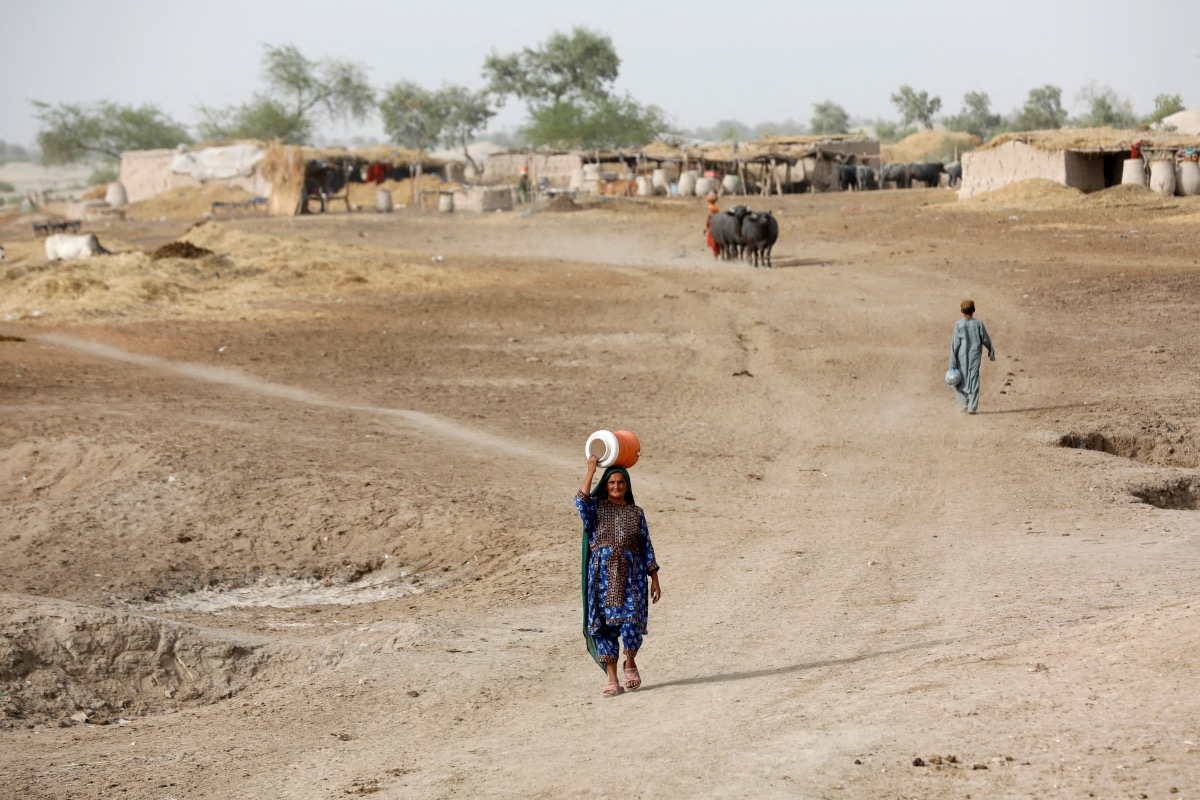Brussels, Belgium
Reuters
This year is “virtually certain” to be the warmest in 125,000 years, European Union scientists said on Wednesday, after data showed last month was the world’s hottest October in that period.
Last month smashed through the previous October temperature record, from 2019, by a massive margin, the EU’s Copernicus Climate Change Service (C3S) said.

A woman walks to fetch water from a nearby hand-pump with a water cooler on her head, during a heatwave, on the outskirts of Jacobabad, Pakistan, on 16th May, 2022. PICTURE: Reuters/Akhtar Soomro/File photo
AUSTRALIA RECORDS DRIEST OCTOBER SINCE 2002 DUE TO EL NINO
Australia recorded the driest October in more than 20 years due to an El Nino weather pattern which has seen hot, dry conditions hit crop yields in one of the world’s largest wheat exporters, the national weather bureau said on Wednesday.
In its regular drought report, the Bureau of Meteorology said last month was Australia’s driest October since 2002, with rainfall 65 per cent below the 1961–1990 average.
It said every part of Australia except the state of Victoria had below-average rainfall and Western Australia state – by far the biggest grain-exporting region – saw its driest October on record.
After three years of plentiful rain, the El Nino weather phenomenon has brought hot and dry weather to Australia, with September the driest since records began in 1900.
Rain in some parts of the country in early October halted a rapid decline in projected crop yields but the country’s wheat harvest is still expected to fall by around 35 per cent this year to some 26 million tons.
“Areas of [rainfall] deficiency have generally expanded and become more severe in south-west Western Australia, south-eastern Queensland, and parts of the Top End in the Northern Territory and far north Queensland. Deficiencies eased in southern Victoria and eastern Tasmania,” the bureau said.
Its long range forecast predicts below-median rainfall through to at least January in northern, western and southern Australia.
– PETER HOBSON, Canberra, Australia/Reuters
“The record was broken by 0.4 degrees Celsius, which is a huge margin,” said C3S Deputy Director Samantha Burgess, who described the October temperature anomaly as “very extreme”.
The heat is a result of continued greenhouse gas emissions from human activity, combined with the emergence this year of the El Nino weather pattern, which warms the surface waters in the eastern Pacific Ocean.
Globally, the average surface air temperature in October was 1.7 degrees Celsius warmer than the same month in 1850-1900, which Copernicus defines as the pre-industrial period.
The record-breaking October means 2023 is now “virtually certain” to be the warmest year recorded, C3S said in a statement. The previous record was 2016 – another El Nino year.
Copernicus’ dataset goes back to 1940.
“When we combine our data with the IPCC, then we can say that this is the warmest year for the last 125,000 years,” Burgess said.
The longer-term data from UN climate science panel IPCC includes readings from sources such as ice cores, tree rings and coral deposits.
The only other time before October a month breached the temperature record by such a large margin was in September, 2023.
“September really, really surprised us. So after last month, it’s hard to determine whether we’re in a new climate state. But now records keep tumbling and they’re surprising me less than they did a month ago,” Burgess said.
Michael Mann, a climate scientist at University of Pennsylvania, said: “Most El Nino years are now record-breakers, because the extra global warmth of El Nino adds to the steady ramp of human-caused warming.”
Climate change is fuelling increasingly destructive extremes. This year, that included floods that killed thousands of people in Libya, severe heatwaves in South America, and Canada’s worst wildfire season on record.
“We must not let the devastating floods, wildfires, storms, and heatwaves seen this year become the new normal,” said Piers Forster, climate scientist at University of Leeds.
“By rapidly reducing greenhouse gas emissions over the next decade, we can halve the rate of warming,” he added.
Despite countries setting increasingly ambitious targets to gradually cut emissions, so far that has not happened. Global CO2 emissions hit a record high in 2022.






